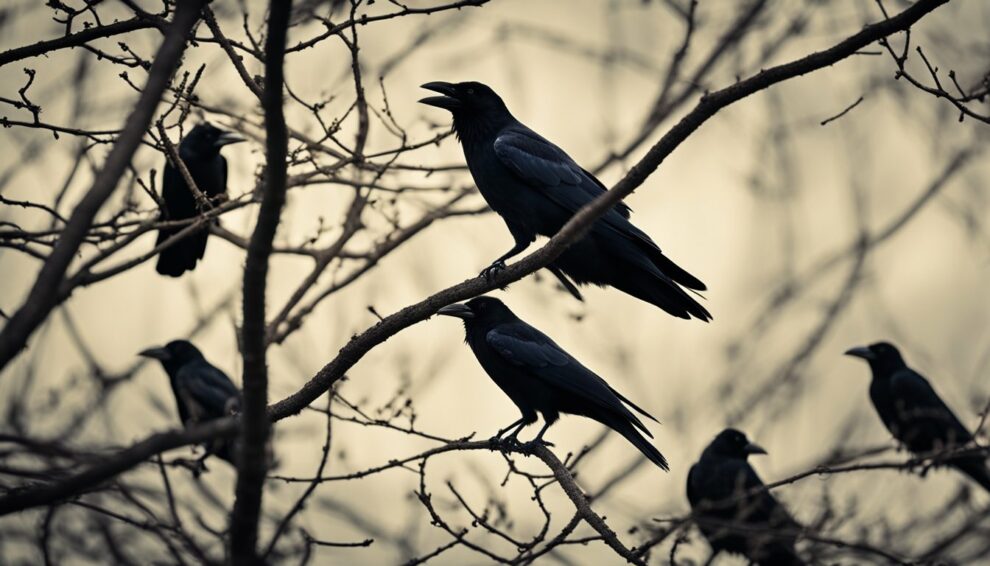Crows are known for their intelligence and their complex social behavior.
In recent years, researchers have been unlocking the secrets of their behavior, shedding light on the inner workings of these remarkable birds.

Crows are highly intelligent creatures that have been the subject of extensive research.
They have been shown to be capable of solving complex puzzles, using tools, and even recognizing human faces.
These abilities have led scientists to conclude that crows are among the most intelligent bird species.
One of the most fascinating aspects of crows is their social nature.
They have complex social structures and are known to engage in a wide range of behaviors, from communal roosting to cooperative breeding.
Researchers have been studying these behaviors in order to better understand the inner workings of these remarkable birds.
By unlocking the secrets of their complex social behavior, scientists hope to gain a deeper understanding of the natural world and the creatures that inhabit it.
The Intricate World of Crow Communication

Crows are known for their complex social behavior, and their communication system is no exception.
These highly intelligent birds use a combination of vocalizations and body movements to convey messages within their community.
Understanding the intricacies of crow communication can reveal a lot about their cognitive abilities and social dynamics.
Understanding Vocalizations
Crows are known for their distinct cawing sounds, but they actually have a wide range of vocalizations that serve different purposes.
For instance, they use soft cooing sounds to communicate with their mates and offspring.
They also use harsh, aggressive caws to warn off potential predators or intruders.
Interestingly, crows can even mimic the sounds of other birds and animals, which may help them blend in or deceive their prey.
Research has shown that crows have a remarkable ability to learn and remember specific vocalizations, which allows them to identify individual birds and recognize different calls for different situations.
This suggests that crows have a high level of cognitive flexibility and adaptability, which is essential for their survival in changing environments.
The Language of Body Movements
In addition to vocalizations, crows also use body movements to communicate with each other.
For example, they use head bobs and wing flaps to signal aggression or submission.
They also use tail fanning and bowing to show off their dominance or attract a mate.
Crows are also known for their ability to use tools, which is another indication of their cognitive prowess.
They can use sticks to extract insects from crevices or even use cars to crack open nuts.
This suggests that crows have a high level of problem-solving skills and creativity, which is not commonly found in other bird species.
In conclusion, crows are fascinating creatures with a complex social behavior that is shaped by their communication system.
By understanding the intricacies of crow communication, we can gain insights into their cognitive abilities and social dynamics.
Whether it’s their vocalizations or body movements, crows have a lot to say and teach us about the natural world.
Crows and Their Ingenious Behaviors
Crows are fascinating creatures that exhibit a wide range of behaviors that are not only complex but also display a strong sense of collaboration and communication within their groups.
These highly intelligent birds have captured the imagination of scientists and nature enthusiasts alike, who have been studying their behavior for decades.
In this section, we will explore some of the most ingenious behaviors of crows.
Tool Use and Problem Solving
One of the most remarkable abilities of crows is their use of tools to solve problems.
They have been observed using sticks, twigs, and even wires to extract insects from tree bark or crevices.
This behavior is not innate but learned through observation and trial and error.
Crows are also capable of making their own tools by modifying sticks or using other objects as tools.
This shows their incredible cognitive abilities and adaptability to their environment.
Playful Antics and Curiosity
Crows are not only intelligent but also playful creatures.
They have been observed engaging in playful activities such as sliding down roofs or playing catch with objects.
This behavior is not only entertaining but also serves a purpose.
Playful activities help crows develop their physical and cognitive abilities, preparing them for the challenges of adulthood.
Crows are also curious creatures that explore their environment and learn from their experiences.
They have been observed investigating new objects or situations, showing a strong sense of curiosity and a desire to learn.
This behavior is essential for their survival, allowing them to adapt to changing environments and find new sources of food.
In conclusion, crows are fascinating creatures that exhibit a wide range of behaviors.
Their intelligence, problem-solving abilities, and playful antics make them a joy to observe and study.
By unlocking the secrets of their complex social behavior, we can gain a deeper understanding of the natural world and the incredible creatures that inhabit it.
Social Dynamics and Family Life

Crows are highly social birds that live in family groups, just like humans.
They form strong bonds and recognize each other’s faces, making them excellent at identifying individuals within their group.
Forming Bonds and Recognizing Faces
Crows have a remarkable ability to recognize human faces, and studies have shown that they can distinguish between friendly and unfriendly faces.
They also have a strong sense of attention to detail, which helps them form strong bonds with other crows.
Nesting Habits and Raising Young
Crows are devoted family members and are community-oriented.
They build their nests in trees or on high structures, and they take great care in raising their young.
Crows are cooperative breeders, which means that they work together to raise their offspring.
Crows are fascinating creatures with complex social behavior. They lead dynamic and complex lives, and their family groups can consist of up to 15 birds.
They are highly adaptable and are known for their intelligence and problem-solving abilities.
Fun fact: Crows are one of the few bird species that use tools.
They have been observed using sticks and other objects to extract food from hard-to-reach places.
In conclusion, crows are incredible birds with complex social behavior.
Their ability to form bonds and recognize faces, as well as their devotion to family life, make them a fascinating subject for study.
Interactions with the Environment

Crows are fascinating creatures that have adapted to various environments. They can be found in urban, suburban, and rural areas.
They are highly adaptable, and their behavior is influenced by the environment they inhabit.
Adapting to Urban Settings
Crows are known for their ability to adapt to urban settings. They are often seen in parks, gardens, and other green spaces in cities.
They have learned to use these areas to their advantage, finding food and shelter in places that were not originally intended for them.
In urban areas, crows have also learned to interact with humans. They are known to scavenge for food in garbage cans and dumpsters.
They have also been observed stealing food from outdoor cafes and restaurants.
This behavior has led some people to view crows as pests, but it is important to remember that they are simply adapting to their environment.
Foraging Strategies and Food Sharing
Crows have a complex social structure that revolves around food sharing.
They are known to share food with other members of their flock, and they have developed a variety of foraging strategies to find food.
One of the most interesting foraging strategies used by crows is tool use.
They have been observed using sticks and other objects to extract food from hard-to-reach places.
This behavior is not common in birds and is a testament to the intelligence of crows.
Crows are also known to share food with other members of their flock.
This behavior is thought to be a way of strengthening social bonds within the group.
It is also a way of ensuring that all members of the group have enough food to survive.
In conclusion, crows are fascinating creatures that have adapted to various environments.
They are highly adaptable and have developed a variety of foraging strategies to find food.
Their complex social structure revolves around food sharing, which is a way of strengthening social bonds within the group.
Frequently Asked Questions

How do crows communicate and work together within their communities?
Crows are highly intelligent birds with complex communication systems.
They have a unique way of communicating with each other about food sources, potential threats, and other important information.
Crows gather in large groups to exchange information with other members of their flock.
They can attract other crows to a specific location by making loud calls and gestures.
They also use body language to communicate with each other, such as head bobbing and wing flapping.
Can you describe the family life and parenting habits of crows?
Crows are devoted family members and community-oriented birds. They are monogamous and mate for life.
Both parents take care of their young and work together to build their nest.
Crows are protective of their offspring and will defend them against any potential threats.
They teach their young how to fly, hunt, and communicate with other crows.
What kind of problem-solving skills do crows possess?
Crows are known for their remarkable problem-solving abilities. They are able to solve complex puzzles, use tools, and even recognize human faces.
They have been the subject of extensive research, revealing their exceptional cognitive skills and adaptability.
Crows have been observed using sticks to extract insects from crevices and using cars to crack nuts.
In what ways do crows demonstrate their intelligence through play?
Crows are playful birds and enjoy engaging in activities that challenge their problem-solving skills.
They have been observed playing games with each other, such as tug-of-war and catch.
They also use their intelligence to create toys out of objects they find in their environment, such as sticks and leaves.
How do crows recognize humans and what does this say about their memory?
Crows have excellent memories and are able to recognize individual humans.
They can remember faces and associate them with specific behaviors, both positive and negative.
This ability to recognize humans demonstrates their intelligence and adaptability.
What are the similarities between crow social behavior and that of humans?
Crows are highly social birds and have complex social structures similar to those of humans.
They form close-knit communities and work together to achieve common goals.
They have been observed mourning the loss of their flock members and even holding funerals.
Crows also demonstrate altruistic behavior, such as sharing food with other members of their flock.
These similarities between crow social behavior and human social behavior suggest that crows are intelligent and empathetic creatures.









